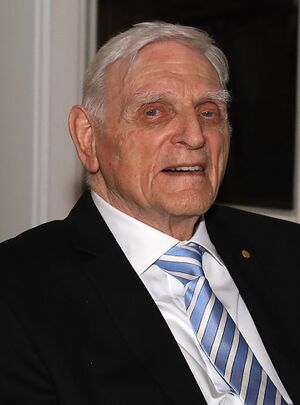John Bannister Goodenough
- Birthdate
- 1922/07/25
- Birthplace
- Jena, Germany
- Death date
- 2023/06/25
- Associated organizations
- National Polytechnic Institute of Grenoble, National Center for Scientific Research
- Fields of study
- Batteries
- Awards
- IEEE Medal for Environmental and Safety Technologies
Biography
John Bannister Goodenough was born on July 25, 1922 in Jena, Germany, and his family returned to the United States shortly after his birth. He attended the Groton School and earned a scholarship to Yale, and during World War II, served in the Army Air Forces. He earned masters degrees and a Ph.D. from the University of Chicago in 1951 and 1952 respectively, and spent six decades at MIT.
The breakthrough discoveries of John Bannister Goodenough, Rachid Yazami, and Akira Yoshino were critical to the development of rechargeable lithium-ion battery technology that has impacted consumer electronics and advanced the performance of electric vehicles. Dr. Goodenough demonstrated a rechargeable cell using lithium cobalt oxide as the positive electrode in 1979 while working at Oxford University. This provided the positive electrode material that would eventually make the lithium-ion battery possible. Goodenough's work showed, with lithium cobalt oxide, that more stable and easy-to-handle negative-electrode materials could be used if assembled in the discharged state. This ultimately opened a new range of possibilities for rechargeable battery systems. Dr. Yazami demonstrated that lithium ions could be inserted electrochemically into graphite using a solid electrolyte in 1980, working with the National Polytechnic Institute of Grenoble and the National Center for Scientific Research (CNRS). Until Dr. Yazami’s innovation, organic electrolytes would decompose in graphite during charging, which was a roadblock to using graphite for the negative electrode. Dr. Yazami’s work paved the way for the graphite negative electrode found in the modern high-capacity lithium-ion battery. Dr. Yoshino filed the first basic patent for the lithium-ion battery in 1985. Working for Asahi Kasei Corporation in Japan, he incorporated lithium cobalt for the positive electrode and a carbonaceous material for the negative electrode. He developed an aluminum foil current collector, and his functional separator and positive temperature coefficient device greatly improved safety compared to other batteries. He also established the coil-wound structure inherent to all lithium-ion batteries. In 1992, Asahi Kasei released the first commercial lithium-ion battery.
A member of the U.S. National Academy of Engineering, the French Academy of Sciences, and a Foreign Member of the British Royal Society, Dr. Goodenough received the Japan Prize in 2001 and the Copley Medal in 2019, and was a co-recipient--along with Yazami and Yoshino--of the 2012 IEEE Medal for Environmental and Safety Technologies. At the time of his death he was the Virginia H. Cockrell Centennial Professor of Engineering at the University of Texas at Austin.
Goodenough died on June 25th, 2023.
